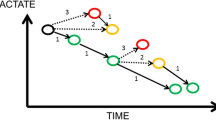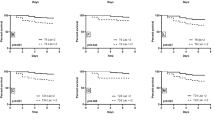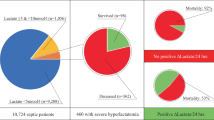Abstract
Purpose
Changes of lactate concentration over time were reported to be associated with survival in septic patients. We aimed to evaluate delta-lactate (ΔLac) 24 h after admission (Δ24Lac) to an intensive care unit (ICU) in critically ill patients for short- and long-term prognostic relevance.
Methods
In total, 26,285 lactate measurements of 2191 patients admitted to a German ICU were analyzed. Inclusion criterion was a lactate concentration at admission above 2.0 mmol/L. Maximum lactate concentrations of day 1 and day 2 were used to calculate Δ24Lac. Follow-up of patients was performed retrospectively. Association of Δ24Lac and both in-hospital and long-term mortality were investigated. An optimal cut-off was calculated by means of the Youden index.
Results
Patients with lower Δ24Lac were of similar age, but clinically sicker. As continuous variable, higher Δ24Lac was associated with decreased in-hospital mortality (per 1% Δ24Lac; HR 0.987 95%CI 0.985–0.990; p < 0.001) and an optimal Δ24Lac cut-off was calculated at 19%. Δ24Lac ≤ 19% was associated with both increased in-hospital (15% vs 43%; OR 4.11; 95%CI 3.23–5.21; p < 0.001) and long-term mortality (HR 1.54 95%CI 1.28–1.87; p < 0.001), even after correction for APACHE II, need for catecholamines and intubation. We matched 256 patients with Δ24Lac ≤ 19% to case–controls > 19% corrected for APACHE II scores, baseline lactate level and sex: Δ24Lac ≤ 19% remained associated with lower in-hospital and long-term survival.
Conclusions
Lower Δ24Lac was robustly associated with adverse outcome in critically ill patients, even after correction for confounders. Δ24Lac might constitute an independent, easily available and important parameter for risk stratification in the critically ill.

Similar content being viewed by others
References
Broder G, Weil MH (1964) Excess lactate: an index of reversibility of schock in human patients. Science 143(3613):1457–1459
Weil MH, Afifi AA (1970) Experimental and clinical studies on lactate and pyruvate as indicators of the severity of acute circulatory failure (shock). Circulation 41(6):989–1001
Bakker J, Nijsten MW, Jansen TC (2013) Clinical use of lactate monitoring in critically ill patients. Ann Intensive Care 3(1):12
Zhang H, Vincent JL (1993) Oxygen extraction is altered by endotoxin during tamponade-induced stagnant hypoxia in the dog. Circ Shock 40(3):168–176
Ronco JJ, Fenwick JC, Tweeddale MG, Wiggs BR, Phang PT, Cooper DJ, Cunningham KF, Russell JA, Walley KR (1993) Identification of the critical oxygen delivery for anaerobic metabolism in critically ill septic and nonseptic humans. JAMA 270(14):1724–1730
Friedman G, de Backer D, Shahla M, Vincent JL (1998) Oxygen supply dependency can characterize septic shock. Intensive Care Med 24(2):118–123
Kraut JA, Madias NE (2014) Lactic acidosis. N Engl J Med 371(24):2309–2319
Hernandez G, Bellomo R, Bakker J (2018) The ten pitfalls of lactate clearance in sepsis. Intensive Care Med. https://doi.org/10.1007/s00134-018-5213-x
James JH, Luchette FA, McCarter FD, Fischer JE (1999) Lactate is an unreliable indicator of tissue hypoxia in injury or sepsis. Lancet 354(9177):505–508
McCarter FD, Nierman SR, James JH, Wang L, King J-K, Friend LA, Fischer JE (2002) Role of skeletal muscle Na+–K+ ATPase activity in increased lactate production in sub-acute sepsis. Life Sci 70(16):1875–1888
Barth E, Albuszies G, Baumgart K, Matejovic M, Wachter U, Vogt J, Radermacher P, Calzia E (2007) Glucose metabolism and catecholamines. Crit Care Med 35(9 Suppl):S508–S518
Jeppesen JB, Mortensen C, Bendtsen F, Møller S (2013) Lactate metabolism in chronic liver disease. Scand J Clin Lab Invest 73(4):293–299
Huckabee WE (1958) Relationships of pyruvate and lactate during anaerobic metabolism. I. Effects of infusion of pyruvate or glucose and of hyperventilation. J Clin Invest 37(2):244–254
Orringer CE, Eustace JC, Wunsch CD, Gardner LB (1977) Natural history of lactic acidosis after grand-mal seizures. A model for the study of an anion-gap acidosis not associated with hyperkalemia. N Engl J Med 297(15):796–799
Vincent JL, Dufaye P, Berré J, Leeman M, Degaute JP, Kahn RJ (1983) Serial lactate determinations during circulatory shock. Crit Care Med 11(6):449–451
Jansen TC, van Bommel J, Bakker J (2009) Blood lactate monitoring in critically ill patients: a systematic health technology assessment. Crit Care Med 37(10):2827–2839
Cecconi M, de Backer D, Antonelli M, Beale R, Bakker J, Hofer C, Jaeschke R, Mebazaa A, Pinsky MR, Teboul JL, Vincent JL, Rhodes A (2014) Consensus on circulatory shock and hemodynamic monitoring. Task force of the European Society of Intensive Care Medicine. Intensive Care Med 40(12):1795–1815
Jung C, Fuernau G, de Waha S, Eitel I, Desch S, Schuler G, Figulla HR, Thiele H (2015) Intraaortic balloon counterpulsation and microcirculation in cardiogenic shock complicating myocardial infarction: an IABP-SHOCK II substudy. Clin Res Cardiol 104(8):679–687
Mikkelsen ME, Miltiades AN, Gaieski DF, Goyal M, Fuchs BD, Shah CV, Bellamy SL, Christie JD (2009) Serum lactate is associated with mortality in severe sepsis independent of organ failure and shock. Crit Care Med 37(5):1670–1677
Manikis P, Jankowski S, Zhang H, Kahn RJ, Vincent JL (1995) Correlation of serial blood lactate levels to organ failure and mortality after trauma. Am J Emerg Med 13(6):619–622
Casserly B, Phillips GS, Schorr C, Dellinger RP, Townsend SR, Osborn TM, Reinhart K, Selvakumar N, Levy MM (2015) Lactate measurements in sepsis-induced tissue hypoperfusion: results from the surviving sepsis campaign database. Crit Care Med 43(3):567–573
Rhodes A, Evans LE, Alhazzani W, Levy MM, Antonelli M, Ferrer R, Kumar A, Sevransky JE, Sprung CL, Nunnally ME, Rochwerg B, Rubenfeld GD, Angus DC, Annane D, Beale RJ, Bellinghan GJ, Bernard GR, Chiche J-D, Coopersmith C, de Backer DP, French CJ, Fujishima S, Gerlach H, Hidalgo JL, Hollenberg SM, Jones AE, Karnad DR, Kleinpell RM, Koh Y, Lisboa TC, Machado FR, Marini JJ, Marshall JC, Mazuski JE, McIntyre LA, McLean AS, Mehta S, Moreno RP, Myburgh J, Navalesi P, Nishida O, Osborn TM, Perner A, Plunkett CM, Ranieri M, Schorr CA, Seckel MA, Seymour CW, Shieh L, Shukri KA, Simpson SQ, Singer M, Thompson BT, Townsend SR, van der Poll T, Vincent J-L, Wiersinga WJ, Zimmerman JL, Dellinger RP (2017) Surviving sepsis campaign: international guidelines for management of sepsis and septic shock: 2016. Crit Care Med 45(3):486–552
Levraut J, Ichai C, Petit I, Ciebiera J-P, Perus O, Grimaud D (2003) Low exogenous lactate clearance as an early predictor of mortality in normolactatemic critically ill septic patients. Crit Care Med 31(3):705–710
Vincent J-L, Quintairos E, Silva A, Couto L, Taccone FS (2016) The value of blood lactate kinetics in critically ill patients: a systematic review. Crit Care 20(1):257
Lichtenauer M, Wernly B, Ohnewein B, Franz M, Kabisch B, Muessig J, Masyuk M, Lauten A, Schulze PC, Hoppe UC, Kelm M, Jung C (2017) The lactate/albumin ratio: a valuable tool for risk stratification in septic patients admitted to ICU. Int J Mol Sci 18(9):1893
Wernly B, Lichtenauer M, Franz M, Kabisch B, Muessig J, Masyuk M, Hoppe UC, Kelm M, Jung C (2017) Model for end-stage liver disease excluding INR (MELD-XI) score in critically ill patients: easily available and of prognostic relevance. PLoS One 12(2):e0170987
Knaus WA, Zimmerman JE, Wagner DP, Draper EA, Lawrence DE (1981) APACHE-acute physiology and chronic health evaluation: a physiologically based classification system. Crit Care Med 9(8):591–597
Le Gall JR, Lemeshow S, Saulnier F (1993) A new Simplified Acute Physiology Score (SAPS II) based on a European/North American multicenter study. JAMA 270(24):2957–2963
Nguyen HB, Rivers EP, Knoblich BP, Jacobsen G, Muzzin A, Ressler JA, Tomlanovich MC (2004) Early lactate clearance is associated with improved outcome in severe sepsis and septic shock. Crit Care Med 32(8):1637–1642
Donnino MW, Miller J, Goyal N, Loomba M, Sankey SS, Dolcourt B, Sherwin R, Otero R, Wira C (2007) Effective lactate clearance is associated with improved outcome in post-cardiac arrest patients. Resuscitation 75(2):229–234
McNelis J, Marini CP, Jurkiewicz A, Szomstein S, Simms HH, Ritter G, Nathan IM (2001) Prolonged lactate clearance is associated with increased mortality in the surgical intensive care unit. Am J Surg 182(5):481–485
Nichol A, Bailey M, Egi M, Pettila V, French C, Stachowski E, Reade MC, Cooper DJ, Bellomo R (2011) Dynamic lactate indices as predictors of outcome in critically ill patients. Crit Care 15(5):R242
Haas SA, Lange T, Saugel B, Petzoldt M, Fuhrmann V, Metschke M, Kluge S (2016) Severe hyperlactatemia, lactate clearance and mortality in unselected critically ill patients. Intensive Care Med 42(2):202–210
Ghneim MH, Regner JL, Jupiter DC, Kang F, Bonner GL, Bready MS, Frazee R, Ciceri D, Davis ML (2013) Goal directed fluid resuscitation decreases time for lactate clearance and facilitates early fascial closure in damage control surgery. Am J Surg 206(6):995–999 (discussion 999–1000)
Jones AE, Shapiro NI, Trzeciak S, Arnold RC, Claremont HA, Kline JA (2010) Lactate clearance vs central venous oxygen saturation as goals of early sepsis therapy: a randomized clinical trial. JAMA 303(8):739–746
Jansen TC, van Bommel J, Schoonderbeek FJ, Sleeswijk Visser SJ, van der Klooster JM, Lima AP, Willemsen SP, Bakker J (2010) Early lactate-guided therapy in intensive care unit patients: a multicenter, open-label, randomized controlled trial. Am J Respir Crit Care Med 182(6):752–761
Hernández G, Cavalcanti AB, Ospina-Tascón G, Zampieri FG, Dubin A, Hurtado FJ, Friedman G, Castro R, Alegría L, Cecconi M, Teboul J-L, Bakker J (2018) Early goal-directed therapy using a physiological holistic view: the ANDROMEDA-SHOCK-a randomized controlled trial. Ann Intensive Care 8(1):52
Hernandez G, Luengo C, Bruhn A, Kattan E, Friedman G, Ospina-Tascon GA, Fuentealba A, Castro R, Regueira T, Romero C, Ince C, Bakker J (2014) When to stop septic shock resuscitation: clues from a dynamic perfusion monitoring. Ann Intensive Care 4:30
Acknowledgements
We would like to thank Katharina Bannier and Julian Gonschorrek for their support in collecting the patients’ follow-up. MM was supported by a GEROK scholarship by the Collaborative Research Center 1116 (DFG).
Author information
Authors and Affiliations
Contributions
MM and BW analyzed and interpreted the data, drafted the submitted manuscript and approved the final version to be published. MF, BK, CJ and PCS substantially contributed to acquisition and interpretation of data, revised the manuscript critically and approved the final version to be published. ML, JMM, AL, UCH and MK substantially contributed to interpretation of data, revised the manuscript critically for important intellectual content and approved the final version to be published. GZ gave statistical advice. JB and CJ substantially contributed to conception and design and to the interpretation of data, revised the manuscript critically for important intellectual content and approved the final version to be published.
Corresponding author
Ethics declarations
Conflicts of interest
The authors declare that they have no conflict of interest.
Ethical approval
The study has been approved by the local ethics committee of the Jena University Hospital.
Electronic supplementary material
Below is the link to the electronic supplementary material.
Rights and permissions
About this article
Cite this article
Masyuk, M., Wernly, B., Lichtenauer, M. et al. Prognostic relevance of serum lactate kinetics in critically ill patients. Intensive Care Med 45, 55–61 (2019). https://doi.org/10.1007/s00134-018-5475-3
Received:
Accepted:
Published:
Issue Date:
DOI: https://doi.org/10.1007/s00134-018-5475-3




